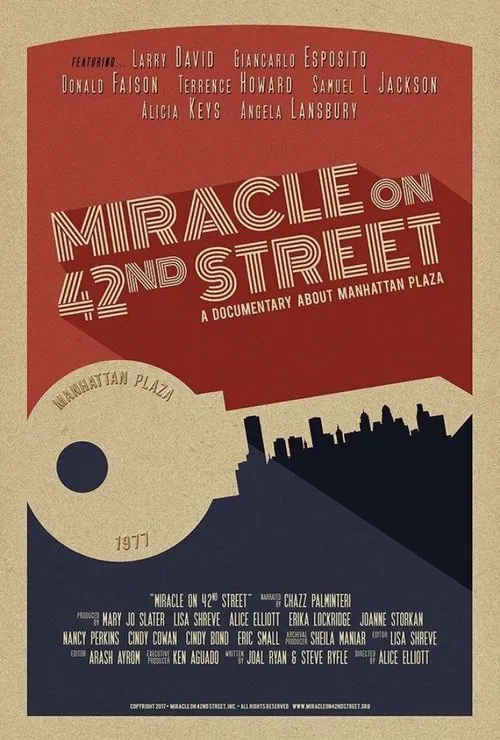Miracle on 42nd Street

Plot
In 2016, director Kristi Zea released the documentary film "Miracle on 42nd Street," which is a heartwarming tribute to the Manhattan Plaza, a one-of-a-kind, subsidized residential building in New York City. The movie tells the captivating story of how this iconic building catered to individuals in the arts, creating an atmosphere that fostered creative growth, camaraderie, and support. At the heart of the documentary are the stories of several Manhattan Plaza residents who rose to prominence in the arts. Among them are Tony Award-winning actress Bernadette Peters, Tony award-winning actor Joel Grey, and award-winning dancer Judith Jamison, among many others. Each of these artists shares with the audience their personal experiences residing at Manhattan Plaza, highlighting the profound impact the building had on their lives and careers. Born out of a need to address a shortage of affordable housing in New York City, Manhattan Plaza was an experimental model in subsidized housing for artists. With assistance from city funding, the developers constructed a high-rise residential building dedicated to providing homes for actors, artists, dancers, musicians, and writers. The building's design was envisioned with communal spaces where residents could socialize, work, and support one another in their artistic pursuits. The film's subjects recount how the building's unique environment encouraged collaborative efforts and a shared sense of community that helped propel their careers. The communal areas within Manhattan Plaza hosted numerous impromptu jam sessions, dance recitals, and other artistic performances that allowed residents to network, exchange ideas, and build lasting relationships. This synergy facilitated opportunities for collaboration, cross-disciplinary inspiration, and the exchange of creative ideas. The documentary captures stunning footage of Manhattan Plaza's stunning architecture and beautifully designed interior spaces, including an airy rooftop where residents would gather and rehearse their craft. A highlight of this space is the "black box" studio, where numerous actors prepared for auditions, including performances in iconic productions like The Producers and the Broadway revival of A Chorus Line. One of the most poignant aspects of the documentary is the personal testimony of former residents, who reveal how Manhattan Plaza became an extension of their family. Residents would often gather in the communal kitchen to cook meals together and share laughter. Others recount how the building's community supported them through the highs and lows of their careers, offering words of encouragement, career advice, or sometimes, just a comforting shoulder to lean on during particularly challenging times. Joel Grey, a legendary actor and dancer, shares with the audience how Manhattan Plaza provided the setting for some of the most pivotal moments in his life. It was during his time at the building that Grey met his future wife, Ericha, and collaborated on numerous projects with other aspiring artists. Grey's reflections serve as a powerful reminder that Manhattan Plaza became not just a home, but a hub for artistic growth, friendship, and mentorship. The Manhattan Plaza was also the epicenter for groundbreaking artistic initiatives, such as the Actors' Equity Association's residency programs and the Theater Arts Council, which aimed to promote community engagement in the arts. These organizations not only helped emerging artists break into the industry but also fostered partnerships between residents and local theaters and organizations. "Miracle on 42nd Street" is a beautifully shot and deeply moving tribute to the power of community when given the right resources. By telling the story of Manhattan Plaza through the words of its residents, the film reminds viewers that even in a world driven by competition and self-promotion, the value of supportive relationships, collaboration, and shared creative spaces cannot be overstated. Ultimately, the film serves as a testament to the indelible mark left by Manhattan Plaza on the lives of its residents and on the Broadway community as a whole. The documentary leaves viewers with a poignant reminder that, even in an often isolating city like New York, supportive communities like those that thrived within Manhattan Plaza can provide the foundation needed to unlock artistic potential and foster lasting connections between creatives.
Reviews
Recommendations




